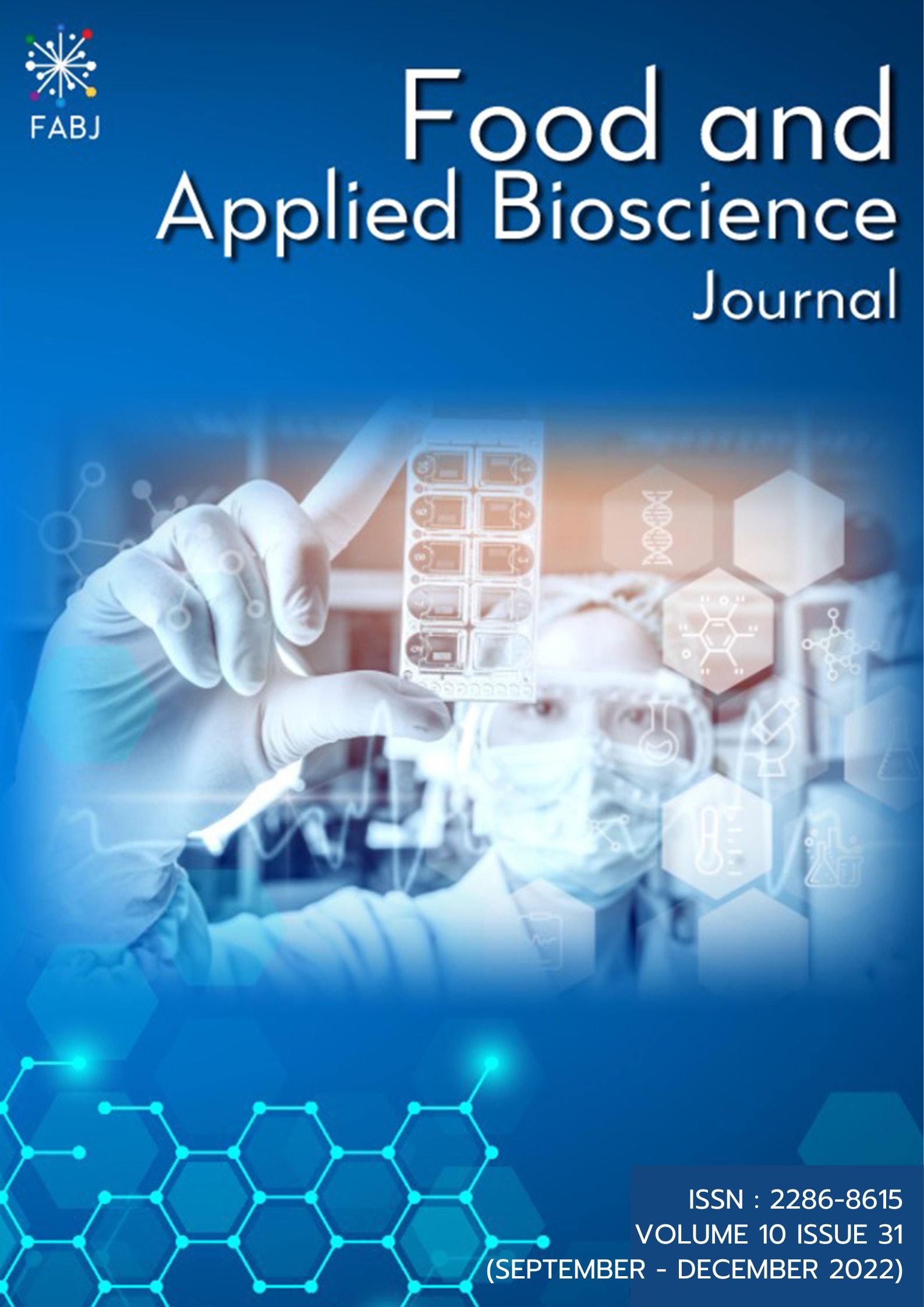The production of vinegar cider from spent coffee grounds
Keywords:
Spent coffee grounds (SCGs), Vinegar, Ethanol production, fermentationAbstract
This study suggests the vinegar production method, which utilizes spent coffee grounds (SCGs) as feedstock. The SCGs were pretreated by biotic degradation to obtain sufficient amounts of glucose. To do so, spore suspension (107 spores/mL) from Aspergillus oryzae and Rhizopus oligosporus were prepared and 10% (v/v) of each suspension was separately introduced to the sterilized SCG mixture (1 g of SCG:100 mL of water). It was found that A. oryzae could produce higher amounts of glucose (54.68 g/L ± 0.08) than R. oligosporus (27.28 g/L ± 0.27). Saccharomyces cerevisiae TISTR 5020 was then inoculated to a liquid medium containing glucose derived from the pre-treatment step under anaerobic condition at 30o C. The alcoholic fermentation was performed and gave a yield of 2.6% ethanol (v/v). After that, the vinegar was produced by the enzymatic reaction from Acetobacter aceti TISTR 102 at 30°C.
The highest amount of acetic acid reached 1.9% within 6 days. The vinegar from the SCGs was analyzed for antioxidant activity via DPPH and ABTS methods in comparison to 4 different kinds of vinegar in the markets including white wine, red wine, apple cider and jasmine rice vinegar. The SCG vinegar was shown to have higher antioxidant activity than some types of vinegar. This is the first study that utilized SCGs as feedstock for vinegar production. With this method, SCGs were not only valorized to vinegar, but also became a novel product for health-concern persons.
References
AOAC, 1998. The Association of Official Analytical Chemists. Official Methods of Analysis of AOAC International. 15th.ed. Washington DC.
Campos-Vega, R., Loarca-Pina, G., Vergara-Castañeda, H. A. and Oomah, B. D. 2015. Spent coffee grounds: A review on current research and future prospects. Trends in Food Science and Technology. 45(1): 24-36.
Cruz, R., Cardoso, M. M., Fernandes, L., Oliveira, M., Mendes, E., Baptista, P., Morais, S. and Casal, S. 2012. Espresso coffee residues: a valuable source of unextracted compounds. Journal of agricultural and food chemistry. 60(32): 7777-7784.
De Leonardis, A., Macciola, V., Iorizzo, M., Lombardi, S. J., Lopez, F. and Marconi, E. 2018. Effective assay for olive vinegar production from olive oil mill wastewaters. Food chemistry. 240: 437-440.
Genualdi, S., Nyman, P. and DeJager, L. 2017. Simultaneous analysis of 3-MCPD and 1, 3-DCP in asian style sauces using QuEChERS extraction and gas chromatography–triple quadrupole mass spectrometry. Journal of agricultural and food chemistry. 65(4): 981-985.
Isham, N. K. M., Mokhtar, N., Fazry, S. and Lim, S. J. 2019. The development of an alternative fermentation model system for vinegar production. LWT-Food Science and Technology. 100: 322-327.
Kondamudi, N., Mohapatra, S. K. and Misra, M. 2008. Spent coffee grounds as a versatile source of green energy. Journal of agricultural and food chemistry. 56(24): 11757-11760.
Lee, B. Q. and Khor, S. M. 2015. 3‐Chloropropane‐1, 2‐diol (3‐MCPD) in soy sauce: A review on the formation, reduction, and detection of this potential carcinogen. Comprehensive Reviews in Food Science and Food Safety. 14(1): 48-66.
Li, T., Lo, Y. M. and Moon, B. 2014. Feasibility of using Hericium erinaceus as the substrate for vinegar fermentation. LWT-Food Science and Technology. 55(1): 323-328.
Miller, G. L. 1959. Use of dinitrosalicylic acid reagent for determination of reducing sugar. Analytical chemistry. 31(3): 426-428.
Moreira, L. R., Álvares, A. d. C. M., da Silva Jr, F. G., de Freitas, S. M. and Ferreira Filho, E. X. 2015. Xylan-degrading enzymes from Aspergillus terreus: Physicochemical features and functional studies on hydrolysis of cellulose pulp. Carbohydrate polymers. 134: 700-708.
Passos, D., Pereira Jr, N. and de Castro, A. M. 2018. A comparative review of recent advances in cellulases production by Aspergillus, Penicillium and Trichoderma strains and their use for lignocellulose deconstruction. Current Opinion in Green and Sustainable Chemistry. 14: 60-66.
Shang, Y. F., Xu, J. L., Lee, W. J. and Um, B.H. 2017. Antioxidative polyphenolics obtained from spent coffee grounds by pressurized liquid extraction. South African Journal of Botan. 109: 75-80.
Sokollek, S. J. and Hammes, W. P. 1997. Description of a starter culture preparation for vinegar fermentation. Systematic and Applied Microbiology. 20(3): 481-491.
Wongsiridetchai, C., Chiangkham, W., Khlaihiran, N., Sawangwan, T., Wongwathanarat, P., Charoenrat, T. and Chantorn, S. 2018. Alkaline pretreatment of spent coffee grounds for oligosaccharides production by mannanase from Bacillus sp. GA2 (1). Agriculture and Natural Resources. 52(3): 222-227.
Xia, T., Yao, J., Zhang, J., Zheng, Y., Song, J. and Wang, M. 2017. Protective effects of Shanxi aged vinegar against hydrogen peroxide-induced oxidative damage in LO2 cells through Nrf2-mediated antioxidant responses. RSC advances. 7(28): 17377-17386.
Downloads
Published
How to Cite
Issue
Section
License
Copyright (c) 2022 Food and Applied Bioscience Journal

This work is licensed under a Creative Commons Attribution-NonCommercial-NoDerivatives 4.0 International License.






